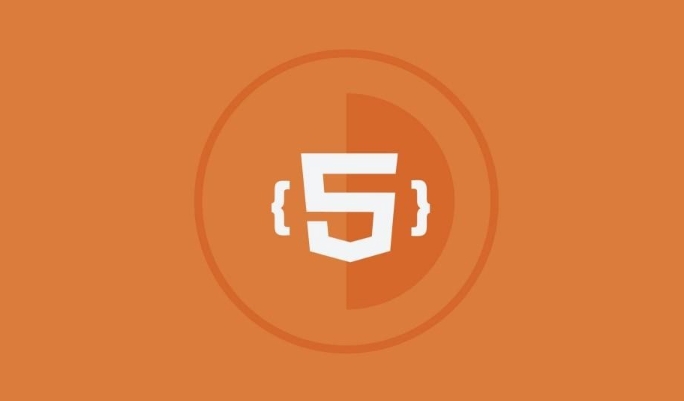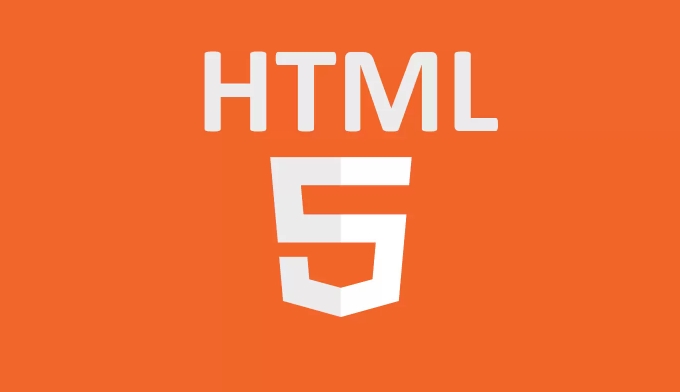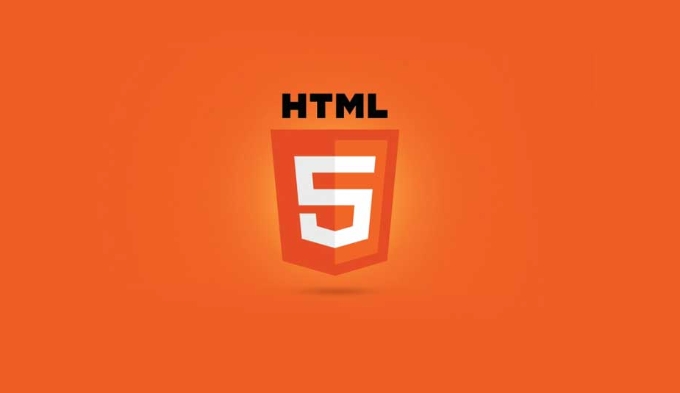Using HTML5's <header> and <footer> elements can improve the clarity and accessibility of web page structure. <header> is usually located at the top of a page or block, and contains introductory content such as site titles, navigation menus or banners; <footer> is often located at the bottom, placing copyright information, contact information or secondary navigation links. Both can be used multiple times and content relevance is required. They support CSS style settings such as background color, margins, and text alignment to enhance visual distinction. However, not all pages must contain these two elements. Simple pages can be omitted according to actual needs, while standard web pages are recommended to improve user experience and SEO results.

When you're building a webpage with HTML5, using the right semantic elements make your code clearer and more accessible. Two of the most useful tags for structuring your page are <header></header> and <footer></footer> . These aren't just for looks — they help browsers, screen readers, and search engines understand what part of the page they're dealing with.
 ` and `<footer> `." />
` and `<footer> `." /> What goes inside a <header></header> ?
A <header></header> typically sits at the top of a page or section and contains introduction content. It's common to include things like:
- The site logo or title
- Navigation menus
- A banner image or heading
You can use it at the top of the whole page, or even inside individual sections or articles. Just keep in mind that each <header></header> should be relevant to the section it belongs to.
 ` and `<footer> `." />
` and `<footer> `." />For example:
<header>
<h1>My Website</h1>
<nav>
<ul>
<li><a href="/">Home</a></li>
<li><a href="/about">About</a></li>
</ul>
</nav>
</header>This structure is clean and tells both users and tools that this area is the top part of your page.
 ` and `<footer> `." />
` and `<footer> `." /> What belongs in a <footer> ?
The <footer> usually appears at the bottom of a page or section, and it often includes:
- Copyright info
- Contact details
- Social media links
- Secondary navigation
Like <header> , a <footer> can be used more than once — for example, at the bottom of a blog post or at the end of the entire website.
Here's a basic example:
<footer>
<p>© 2025 My Website. All rights reserved.</p>
<ul>
<li><a href="/contact">Contact</a></li>
<li><a href="/privacy">Privacy Policy</a></li>
</ul>
</footer>Just make sure not to put unrelated stuff in there. Stick to closing information or links that help wrap up the page.
Can I style them with CSS?
Yes, absolutely. Since <header> and <footer> are block-level elements, you can style them just like any other <div> . For instance, you might want to center the text in your footer or give your header a background color.
Some common styling tips:
- Use
margin: 0 autoto center align your header or footer content - Add padding so text doesn't stick to the edge
- Set background colors or borders to visually separate these sections
Example:
header {
background-color: #f5f5f5;
padding: 20px;
text-align: center;
}
footer {
font-size: 0.9em;
color: #666;
padding: 15px;
}These styles help make those areas stand out without being too flashy.
Do I need both on every page?
Not necessary. Some pages, especially simple ones like a thank-you screen or an error page, might not need a full header or footer. But for most standard web pages — especially blogs, business sites, or portfolios — including both helps with usability and SEO.
If you're leaving one out, ask yourself: does the user know where they are and how to get around? If not, consider adding at least a basic version.
That's the basics of using <header></header> and <footer></footer> in HTML5. They're straightforward but powerful tools for organizing your content and making your site easier to navigate.
The above is the detailed content of Defining page headers and footers with HTML5 `` and ``.. For more information, please follow other related articles on the PHP Chinese website!

Hot AI Tools

Undress AI Tool
Undress images for free

Undresser.AI Undress
AI-powered app for creating realistic nude photos

AI Clothes Remover
Online AI tool for removing clothes from photos.

Clothoff.io
AI clothes remover

Video Face Swap
Swap faces in any video effortlessly with our completely free AI face swap tool!

Hot Article

Hot Tools

Notepad++7.3.1
Easy-to-use and free code editor

SublimeText3 Chinese version
Chinese version, very easy to use

Zend Studio 13.0.1
Powerful PHP integrated development environment

Dreamweaver CS6
Visual web development tools

SublimeText3 Mac version
God-level code editing software (SublimeText3)

Hot Topics
 Audio and Video: HTML5 VS Youtube Embedding
Jun 19, 2025 am 12:51 AM
Audio and Video: HTML5 VS Youtube Embedding
Jun 19, 2025 am 12:51 AM
HTML5isbetterforcontrolandcustomization,whileYouTubeisbetterforeaseandperformance.1)HTML5allowsfortailoreduserexperiencesbutrequiresmanagingcodecsandcompatibility.2)YouTubeofferssimpleembeddingwithoptimizedperformancebutlimitscontroloverappearanceand
 What is the purpose of the input type='range'?
Jun 23, 2025 am 12:17 AM
What is the purpose of the input type='range'?
Jun 23, 2025 am 12:17 AM
inputtype="range" is used to create a slider control, allowing the user to select a value from a predefined range. 1. It is mainly suitable for scenes where values ??need to be selected intuitively, such as adjusting volume, brightness or scoring systems; 2. The basic structure includes min, max and step attributes, which set the minimum value, maximum value and step size respectively; 3. This value can be obtained and used in real time through JavaScript to improve the interactive experience; 4. It is recommended to display the current value and pay attention to accessibility and browser compatibility issues when using it.
 Adding drag and drop functionality using the HTML5 Drag and Drop API.
Jul 05, 2025 am 02:43 AM
Adding drag and drop functionality using the HTML5 Drag and Drop API.
Jul 05, 2025 am 02:43 AM
The way to add drag and drop functionality to a web page is to use HTML5's DragandDrop API, which is natively supported without additional libraries. The specific steps are as follows: 1. Set the element draggable="true" to enable drag; 2. Listen to dragstart, dragover, drop and dragend events; 3. Set data in dragstart, block default behavior in dragover, and handle logic in drop. In addition, element movement can be achieved through appendChild and file upload can be achieved through e.dataTransfer.files. Note: preventDefault must be called
 How can you animate an SVG with CSS?
Jun 30, 2025 am 02:06 AM
How can you animate an SVG with CSS?
Jun 30, 2025 am 02:06 AM
AnimatingSVGwithCSSispossibleusingkeyframesforbasicanimationsandtransitionsforinteractiveeffects.1.Use@keyframestodefineanimationstagesforpropertieslikescale,opacity,andcolor.2.ApplytheanimationtoSVGelementssuchas,,orviaCSSclasses.3.Forhoverorstate-b
 HTML audio and video: Examples
Jun 19, 2025 am 12:54 AM
HTML audio and video: Examples
Jun 19, 2025 am 12:54 AM
Audio and video elements in HTML can improve the dynamics and user experience of web pages. 1. Embed audio files using elements and realize automatic and loop playback of background music through autoplay and loop properties. 2. Use elements to embed video files, set width and height and controls properties, and provide multiple formats to ensure browser compatibility.
 What is WebRTC and what are its main use cases?
Jun 24, 2025 am 12:47 AM
What is WebRTC and what are its main use cases?
Jun 24, 2025 am 12:47 AM
WebRTC is a free, open source technology that supports real-time communication between browsers and devices. It realizes audio and video capture, encoding and point-to-point transmission through built-in API, without plug-ins. Its working principle includes: 1. The browser captures audio and video input; 2. The data is encoded and transmitted directly to another browser through a security protocol; 3. The signaling server assists in the initial connection but does not participate in media transmission; 4. The connection is established to achieve low-latency direct communication. The main application scenarios are: 1. Video conferencing (such as GoogleMeet, Jitsi); 2. Customer service voice/video chat; 3. Online games and collaborative applications; 4. IoT and real-time monitoring. Its advantages are cross-platform compatibility, no download required, default encryption and low latency, suitable for point-to-point communication
 How to create animations on a canvas using requestAnimationFrame()?
Jun 22, 2025 am 12:52 AM
How to create animations on a canvas using requestAnimationFrame()?
Jun 22, 2025 am 12:52 AM
The key to using requestAnimationFrame() to achieve smooth animation on HTMLCanvas is to understand its operating mechanism and cooperate with Canvas' drawing process. 1. requestAnimationFrame() is an API designed for animation by the browser. It can be synchronized with the screen refresh rate, avoid lag or tear, and is more efficient than setTimeout or setInterval; 2. The animation infrastructure includes preparing canvas elements, obtaining context, and defining the main loop function animate(), where the canvas is cleared and the next frame is requested for continuous redrawing; 3. To achieve dynamic effects, state variables, such as the coordinates of small balls, are updated in each frame, thereby forming
 How to check if a browser can play a specific video format?
Jun 28, 2025 am 02:06 AM
How to check if a browser can play a specific video format?
Jun 28, 2025 am 02:06 AM
To confirm whether the browser can play a specific video format, you can follow the following steps: 1. Check the browser's official documents or CanIuse website to understand the supported formats, such as Chrome supports MP4, WebM, etc., Safari mainly supports MP4; 2. Use HTML5 tag local test to load the video file to see if it can play normally; 3. Upload files with online tools such as VideoJSTechInsights or BrowserStackLive for cross-platform detection. When testing, you need to pay attention to the impact of the encoded version, and you cannot rely solely on the file suffix name to judge compatibility.






